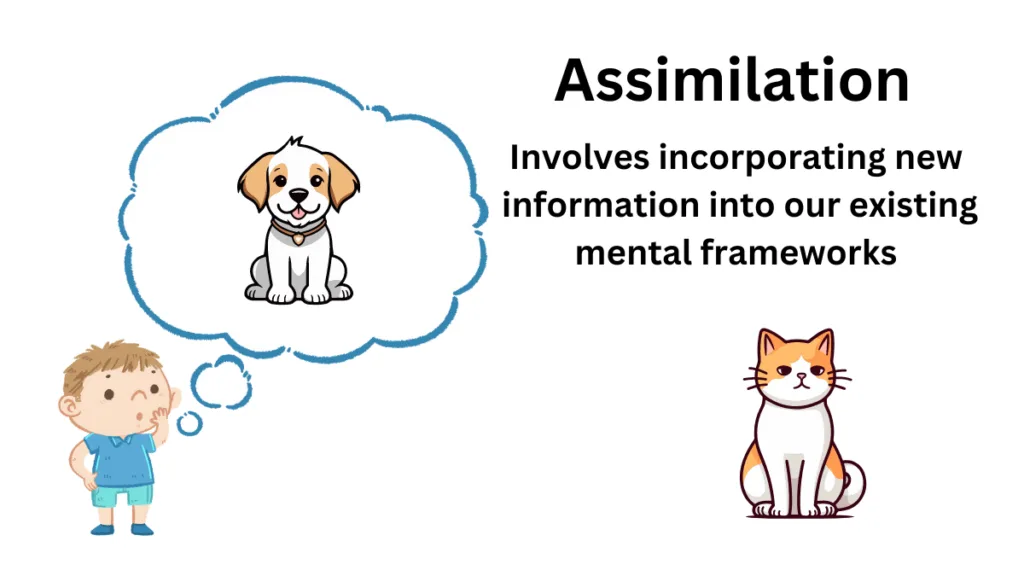Psychological assimilation refers to the process of incorporating new information or experiences into existing mental frameworks or schemas. When we assimilate new information, we fit it into pre-existing cognitive structures. When we do this, we are able to make sense of the world around us.
It can be contrasted with accommodation, another concept introduced by psychologist Jean Piaget. While assimilation involves incorporating new information into existing schemas, accommodation involves modifying existing schemas or creating new ones to accommodate new information.
Jean Piaget, a renowned developmental psychologist, emphasized the importance of assimilation in cognitive development. According to Piaget, assimilation is a key mechanism through which individuals adapt to their environment and acquire new knowledge.
Assimilation in psychology involves incorporating new information into existing mental frameworks or schemas. It is a fundamental process in cognitive development, allowing individuals to adapt to their environment and acquire new knowledge.
Assimilation in Psychology vs. Accommodation
Psychological assimilation and accommodation are two distinct psychological concepts, both were introduced by Jean Piaget. While assimilation involves incorporating new information into existing schemas, accommodation involves modifying existing schemas or creating new ones to accommodate new information.
Psychological assimilation differs from accommodation in terms of the cognitive processes involved.
When individuals assimilate new information, they fit it into their existing mental frameworks or schemas. This allows them to make sense of the new information based on their pre-existing knowledge and understanding.
For example, if a child has a schema for dogs and encounters a cat for the first time, they may assimilate the cat into their existing schema for dogs, perceiving the cat as a type of dog.
On the other hand, accommodation requires individuals to modify their existing schemas or create new ones to accommodate new information. This occurs when the new information cannot be easily assimilated into existing schemas.
In the example of the child encountering a cat, if the child realizes that cats have distinct characteristics that differentiate them from dogs, they may need to accommodate their schema by creating a separate schema for cats.
Psychological assimilation involves incorporating new information into existing schemas, while accommodation involves modifying or creating new schemas. Both processes are essential for cognitive development and allow individuals to adapt to their environment and acquire new knowledge.
Jean Piaget’s View on Assimilation

Jean Piaget was a Swiss psychologist who played a significant role in the study of cognitive development and the concept of assimilation.
Piaget believed that assimilation is a fundamental process in which individuals incorporate new information into their existing mental frameworks or schemas. According to Piaget, assimilation allows individuals to make sense of the world by relating new experiences to their pre-existing knowledge.
Piaget’s view on assimilation emphasized the importance of active learning and the role of schemas. He proposed that individuals have mental structures called schemas, which are frameworks that organize and interpret information. These schemas are developed through experiences and interactions with the environment.
Piaget argued that when individuals encounter new information that can be easily assimilated into their existing schemas, they assimilate it without much cognitive effort.
However, if the new information does not fit into their existing schemas, they experience a state of cognitive disequilibrium. This state motivates individuals to modify their existing schemas or create new ones through accommodation.
In Piaget’s view, assimilation and accommodation work together to promote cognitive development. Through assimilation, individuals expand their existing knowledge and understanding, while accommodation allows for the creation of new knowledge and the adaptation to new experiences.
Piaget’s view on assimilation highlights its crucial role in cognitive development and the construction of knowledge. By incorporating new information into existing schemas, individuals can make sense of the world and continue to grow intellectually.
Examples of Psychological Assimilation
Psychological assimilation can be observed in various situations and contexts. One common example is when a child encounters a new animal for the first time.
If the child has a schema for dogs, they may initially assume that the new animal is also a dog. This is an example of assimilation, as the child incorporates the new information (the new animal) into their schema (dogs).
Another example of psychological assimilation can be seen in language acquisition. When learning a new language, individuals often try to fit new words and grammar structures into their existing linguistic framework.
For instance, if someone is learning Spanish and already knows French, they may assimilate Spanish words by pronouncing them with a French accent or using French grammar rules. This assimilation helps them make sense of the new language based on their existing knowledge.
In the field of psychology, assimilation can also occur when individuals encounter new information that aligns with their preconceived beliefs or biases. For example, if someone strongly believes in a particular political ideology, they may assimilate new information that supports their beliefs while disregarding or dismissing contradictory evidence.
This selective assimilation allows individuals to maintain consistency in their beliefs and avoid cognitive dissonance. These examples illustrate how psychological assimilation operates in different domains, from cognitive development to language acquisition and belief systems.
By assimilating new information into existing schemas, individuals can make sense of their experiences and continue to build their understanding of the world around them.
The Role of Schemas in Assimilation
Schemas play a crucial role in the process of assimilation in psychology. A schema can be defined as a mental framework or structure that helps individuals organize and interpret new information based on their existing knowledge and experiences.
When encountering new information, individuals tend to assimilate it by fitting it into their existing schemas. Schemas act as filters through which individuals perceive and make sense of the world around them.
They provide a framework for understanding and categorizing new experiences, objects, or ideas.
For example, let’s consider a child who has a schema for birds. When the child sees a new bird with bright colors and a long beak, they may assimilate it into their existing schema for birds. This assimilation allows the child to make sense of the new bird based on their previous knowledge of birds.
However, schemas can also lead to biases and limitations in assimilation. Individuals with rigid or narrow schemas may struggle to incorporate new information that does not fit within their existing framework. This can result in resistance to change or a tendency to dismiss contradictory information.
Summary
Assimilation in psychology refers to the process by which individuals incorporate new information into their existing knowledge and understanding. It involves fitting new experiences, objects, or ideas into pre-existing mental frameworks called schemas. Schemas act as filters through which individuals perceive and make sense of the world around them.
Assimilation differs from accommodation, which involves modifying existing schemas or creating new ones to incorporate new information that cannot be assimilated. While assimilation allows individuals to make sense of new information based on their existing knowledge, accommodation enables them to adapt and expand their understanding.
Jean Piaget emphasized the importance of assimilation in cognitive development. He believed that assimilation and accommodation work together to shape individuals’ understanding of the world and promote intellectual growth.
Examples of assimilation can be seen in everyday life. For instance, a child with a schema for dogs may assimilate a new breed of dog into their existing schema. This allows them to recognize the new dog as a variation of what they already know.
By understanding the role of schemas and the distinction between assimilation and accommodation, we can gain insights into how individuals learn, develop, and navigate their psychological experiences.
Sources:
Gebhardt S, Grant P, von Georgi R, Huber MT. Aspects of Piaget’s cognitive developmental psychology and neurobiology of psychotic disorders – an integrative model. Med Hypotheses. 2008;71(3):426-433. doi:10.1016/j.mehy.2008.03.042
Leipold B, Bermeitinger C, Greve W, Meyer B, Arnold M, Pielniok M. Short-term induction of assimilation and accommodation. Q J Exp Psychol (Hove). 2014;67(12):2392-2408. doi:10.1080/17470218.2014.931443
Gebhardt S, Grant P, von Georgi R, Huber MT. Aspects of Piaget’s cognitive developmental psychology and neurobiology of psychotic disorders – an integrative model. Med Hypotheses. 2008;71(3):426-433. doi:10.1016/j.mehy.2008.03.042
